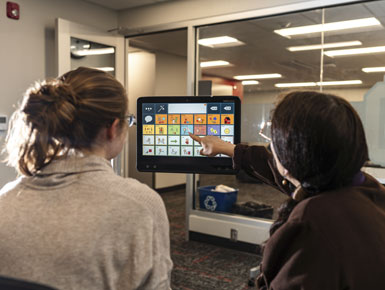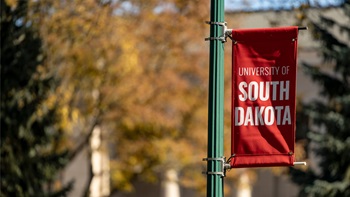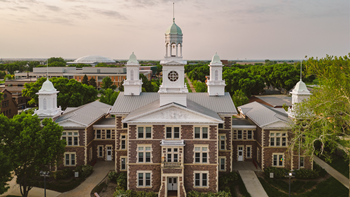Unlocking Communication: Elizabeth Hanson Transforms Lives Through Augmentative and Alternative Communication

“Communication underlies everything human beings do,” says Hanson.
Consider if your ability to communicate was thwarted by a disease such as Parkinson’s or amyotrophic lateral sclerosis (ALS), a brain injury that can happen in a stroke, or even a congenital condition or neurodiversity that impacted your communication ability from childhood and beyond.
“How would that affect all the things that you do and all the roles you play?” Hanson asks.
Hanson’s research and clinical work assists people of all ages impacted by speech disorders so that they can learn new ways to communicate, including an area of speech therapy known as augmentative and alternative communication, or AAC.
“We can get in there and help people develop communication skills,” Hanson explains. “Better communication skills may mean different skills so that they can become or continue to be participants in life.
“What has always gripped me about AAC is that it’s a way to find effective paths of communication for anybody, regardless of what their abilities are,” Hanson continues. “If you have somebody who is locked into their body and unable to talk, we can find a way to get them reconnected with communication. It might not be speech, but we can find a way, and it will be a combination of technology and other low-tech, common-sense approaches.”
AAC refers to ways people’s ability to communicate can be supplemented, adding to speech skills that are available (augmentative), or ways that those who are unable to use verbal language to communicate without words (alternative).
For example, AAC can refer to creating meaning by using gestures or facial expressions such as blinking, writing or drawing a message, pointing to words or letters, or even high-tech options such as using an app or a computer-generated voice.
Hanson points to the late Stephen Hawking, the genius theoretical physicist who was diagnosed with ALS. Hawking later communicated with various means of AAC, including a hand-controlled switch to select words from a computer database with an accompanied computer voice. Later he controlled the speech device with movements of his cheek muscles.
“Hawking was one of the biggest intellects in the world. He just needed an outlet to get his thoughts out,” Hanson says.
AAC also assists people who have intellectual disabilities or children who are born with conditions that can complicate communication.
“They are going to have different needs when it comes to communicating because they must learn their language. They will learn language through other modalities because their speech is not effective or they can’t talk,” Hanson explains.
AAC computer applications are available for neurodivergent children to assist with message creation before spoken words are available or if the child’s words are not understandable. Hanson explains that using a communication app does not take away from the child’s ability to talk, nor will a child’s use of AAC predict what their communication outcome will be.
Instead, she says, “At some point they may become talkers, using their speech to communicate. But in the meantime, we give them a way to learn to communicate. We can’t just sit on our hands and wait for speech to develop.”
Apps with synthesized speech, or what is commonly referred to as a computer voice, are readily available in languages such as English, Spanish or Chinese, but heritage languages are not yet mainstream. “The development of AAC apps in different languages is population based, depending upon the demand for that type of language,” Hanson says.
Hanson is part of an ongoing project to develop an AAC app for non-speaking children that includes synthesized voices for the Lakota language. She points out that there are efforts today to preserve the Lakota language, including using the language in select immersion schools and by other community programs. However, Lakota language instruction might not “work with kids with communication disorders or kids with disabilities in general,” especially when the technology isn’t available for them, Hanson points out.
The AAC app has Lakota vocabulary programmed in the system with picture buttons depicting culturally appropriate symbols or pictures where possible. Hanson says one aspect of the project is finding culturally relevant symbols to represent concepts. More complexity arises from putting together the various vocabulary words into conversational speech so that the computer voice (synthesized speech) uses the patterns of the spoken language, what Hanson refers to as “the melody of their speech.”
For example, we usually do not produce the distinct sounds of each word in a sentence unless we want to emphasize the individual words. In conversational speech, words run together, and the way we use tone of voice depends upon context, sentence type (question or statement, for example), and complexities such as rhythm, pitch and intonation.
The Lakota language has its own vocal qualities of language production that make it incongruent with English-speaking language patterns. “The problem is most of the algorithms for producing synthesized speech are based on English. You cannot take those speech sounds from Lakota and just plug them into an English-producing algorithm,” Hanson clarifies.
The work is “painstaking,” but Hanson reiterates, “There is potential.”
“It is great to join the effort to develop these types of tools for people who have communication disorders and who speak Indigenous languages or want to be able to,” she continues.
Hanson’s research extends beyond AAC to later-in-life speech disorders as well.
“Over the years, my research has touched on a lot of populations. I’m interested in the capacity to help in many ways and so many different people,” she states.
Another area of Hanson’s expertise is in motor speech disorders. Motor speech disorders often result from neurodegenerative conditions such as ALS or Parkinson’s disease, or from other types of brain injury. In the case of degenerative conditions, Hanson’s message to her clients is “We’re going to keep you talking for as long as possible, and if your speech doesn’t work, we’ll keep you communicating.”
Speech therapy can be useful early in diagnosis of a condition later in life, such as Parkinson’s disease. “People might not have insight that their speech is affected and that it might get worse. Therapy helps people get ahead of that because they get training to focus on speaking with intent,” Hanson states.
Hanson has won a grant three years in a row that provides training in the speech therapy approaches developed by the Parkinson Voice Project. The grant provides online training which covers both neurology and information about Parkinson’s, accentuating what motor speech disorder students are already learning in class.
Those enrolled in training learn how to facilitate individual therapy sessions in a program called SPEAK OUT!®.
“It’s a very mindful approach. They take speech and remove it from being automatic to making it intentional. That can be applied to all aspects of life,” Hanson says.
As part of their graduate program, students studying speech-language pathology in USD’s Department of Communication Disorders work directly with patients with communication disorders in the department’s working clinic on the USD campus. Once they’ve had the specific training do provide SpeakOUT!® therapy, the students can work with people with Parkinson’s as part of their practical training.
Additionally, the working clinic has teletherapy capabilities. "We can serve anybody in any state if they have a Wi-Fi signal," Hanson says.
Hanson also worked with a local businessman, Tim Schut, who is losing his ability to speak because of a very rare neurodegenerative condition called Primary Progressive Apraxia of Speech (PPAOS). She has had Schut speak to her class on motor speech disorders for the past two years.
His story helps students expand their understanding of communication disorders to include the personal side and the impact on families and life beyond the clinic room. Through telehealth platforms, Hanson directed graduate students in speech-language pathology as they worked with Schut on a case study. The purpose was to document the course of his disease and various speech treatments for apraxia through EEG and speech intelligibility measures.
Through clinical work, research and teaching, Hanson’s passion is in helping people develop the capacity to be engaged in their lives.
“Communication underlies all the different roles we fill in life. When we help people to communicate, we’re helping them to attain or regain those roles in life. That’s what keeps me in this field,” Hanson emphasized.
The Speech, Language and Hearing Clinic is in the McKusick Technology Center. For more information, call 605-658-3870 or visit the clinic's website.




